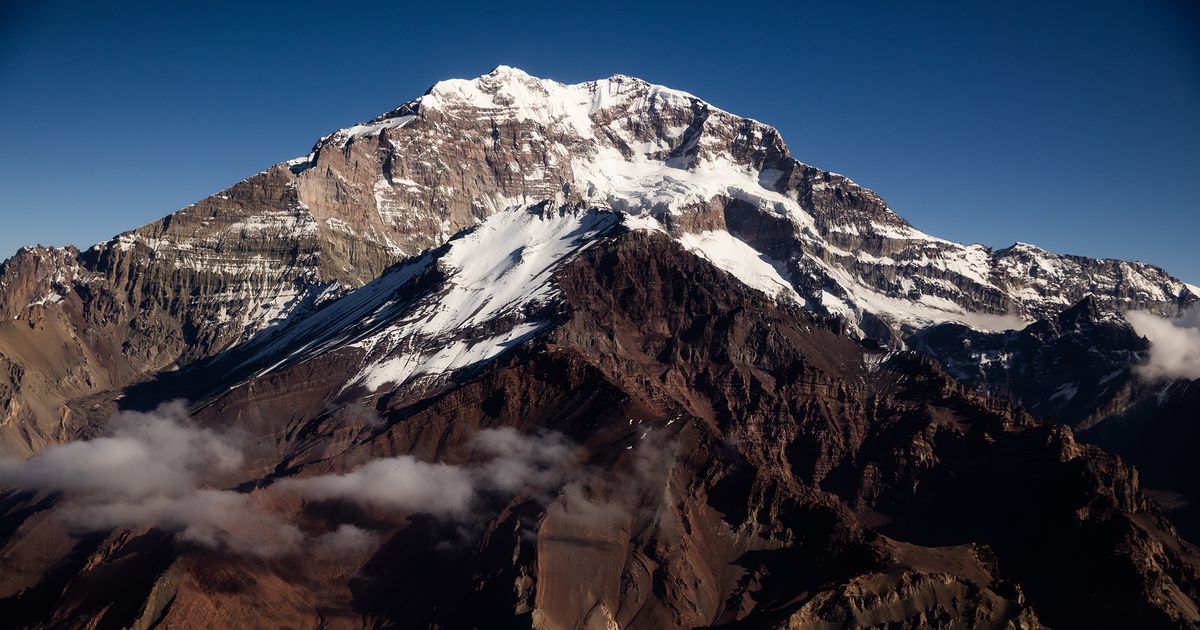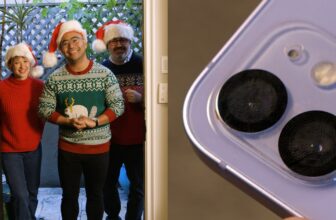
[ad_1]
High on Mount Aconcagua, the Western Hemisphere’s highest mountain, the shrinking Polish Glacier spits out what it once devoured – in this case, a 50-year-old Nikomat 35 mm camera.
Two porters, preparing for an upcoming expedition, had been securing ropes in the thin and arid air of a clear February day. It was midsummer in South America. The camera glistened in the sun, daring to be noticed.
The lens was shattered. A dial on top showed that 24 photographs had been taken.
The bottom half of the camera was saddled into a worn leather holster with a thick strap. On the holster, in blue embossing tape, was an American name and a Colorado address.
In the snow-and-ice seasonal cycles of the mountains, abandoned and lost equipment is discovered each summer – tattered tents, dropped ice axes, lost mittens. Occasionally, a body.
This was not just another camera, though the porters did not know that yet. One of them carried it down to camp. There, a veteran guide named Ulises Corvalan was cooking lunch.
Corvalan glanced up. He casually asked about the name on the bottom of the camera.
“Janet Johnson,” came the reply.
Corvalan gasped and swore. “Janet Johnson!?” he shouted.
Excitement boiled instantly. Do you know about Janet Johnson, the schoolteacher? About John Cooper, the NASA engineer? About the deadly 1973 American expedition?
Have you heard the legend?
It had been handed down for decades, veering toward myth, whispered like a ghost story.
Here is what was certain: A woman from Denver, maybe the most accomplished climber in the group, had last been seen alive on the glacier. A man from Texas, part of the recent Apollo missions to the moon, lay frozen nearby.
There were contradictory statements from survivors and a hasty departure. There was a judge who demanded an investigation into possible foul play. There were three years of summit-scratching searches to find and retrieve the bodies.
Their discovery stirred more intrigue, leaving more questions than answers. That’s the imbalance of all the best mysteries – facts that don’t quite add up, gaps that imaginations rush to fill.
That is how Johnson and Cooper became part of the folklore of Aconcagua.
And now, nearly five decades later, an old camera has emerged from the receding glacier. It was wound, prepared to take the next picture.
Like that, by the whims of climate change and chance, a long-lost legend was given air and light.
The Team
Aconcagua is the broad-shouldered behemoth of the Andes, shaped more like a fist than a finger.
The first person known to reach the 22,838-foot summit was Matthias Zurbriggen of Switzerland, in 1897. In 1934, a Polish expedition successfully tackled a more perilous route on the northeastern side of Aconcagua, up a massive glacier that stretches nearly 2,000 vertical feet toward the summit.
The ice sheet was named for that group: El Glaciar de los Polacos. The Polish Glacier.
Through 2022, there have been 153 known deaths on the mountain. In 1973, Johnson and Cooper were Nos. 26 and 27.
Fifty years ago, Aconcagua had only the most rudimentary of services. Climbers had no GPS trackers, no way to communicate between base camp and the summit. The Americans carried binoculars and a flare gun.
The Climbing Party
Most of them were part of the Mazamas climbing club, founded in Oregon in 1894. Their leader was a Portland, Oregon, lawyer named Carmine Dafoe, known as Carmie.
Dafoe, 52, pushed for the Aconcagua trip, noting that a Mazamas member had climbed it in the 1940s. His group, Dafoe announced, would attempt to be the fifth expedition to top Aconcagua via the Polish Route.
The guide would be Miguel Alfonso, a 38-year-old Argentine who had been to the summit five times, once up the Polish Route. Dafoe asked for a $50 deposit from anyone interested, along with a list of successful ascents and references.
In June 1972, Dafoe announced the members of the party, all American men, whom he briefly described. Jim Petroske, a psychiatrist from Portland, would be “deputy leader,” he said. Bill Eubank, a physician from Kansas City, Missouri, was “highly recommended by Petroske” and would be the expedition doctor. Then came Arnold McMillen, a dairy farmer from Otis, Oregon, and Bill Zeller, a police officer in Salem, Oregon. (“Bill and I shared a blizzard in the Canadian Rockies in ’69, a solid citizen.”) John Shelton, 25, was a Brigham Young geology student fluent in Spanish from a two-year church mission. (“Been through Latin American customs about 25 times – which must take more energy than climbing Aconcagua.”) And John Cooper, a NASA engineer from Houston, was “highly recommended.”
They were weekend climbers, mostly. Dafoe organized hikes in the Northwest designed as training and get-to-know-you exercises.
In November, Dafoe announced the final member of the eight-person American crew: a woman from Denver named Janet Johnson.
She was born on Nov. 30, 1936, and never knew her birth mother. She was adopted by Victor and Mae Johnson, who lived in a stone-and-timber Tudor on the south side of Minneapolis.
The Johnsons believed in manners, rules and God. Janet, with a tidy bedroom upstairs, was a quiet girl and a voracious reader. She needed glasses early. She played organ at St. John’s Lutheran Church.
When she was 10, she wanted a baby sister, so the Johnsons adopted a 5-year-old girl named Judie. The new sisters met at the neighborhood park. Janet took Judie home and gave her a doll named Lois.
Janet Johnson never married or had children. Judie Abrahamson, now an 83-year-old widow in Oregon City, Oregon, is the only close relative alive.
It was when her sister was away at college that Abrahamson discovered notes hidden in a jewelry box – love notes between her sister and another young woman. Soon, Johnson’s parents sent her to a hospital in St. Paul, Minnesota, to “cure” her of her homosexuality. She was about 21.
“It didn’t heal her,” Abrahamson said. “But that was a big rift between Janet and my mother.”
It chased Johnson away from home. She settled in Denver. She got her teaching certificate, then a master’s degree, eventually a doctorate in education at the University of Colorado. She taught in elementary schools and then became a school librarian, figuring it would be easier to keep her nights and weekends free for the mountains.
Johnson joined the Colorado Mountain Club. By 30, she became the 82nd known person – and among the first 20 women – to reach the summit of each of Colorado’s “fourteeners,” the more than 50 peaks higher than 14,000 feet in elevation.
She took the 1972-73 school year off. That fall, after a hiking trip in Europe, she proudly joined the upcoming Mazamas expedition to Aconcagua.
She packed her belongings into an aluminum-frame backpack. She used a marker to write her name or initials on most of them. She wore a silver watch and a ring with a brown stone that she got on a trip to New Mexico.
And she brought the Nikomat, the consumer version of Nikon’s professional cameras of the era.
She used a label maker to punch her name and address onto blue embossing tape, and stuck it to the bottom of the leather camera case, just in case she lost it.
The Climb
American newspapers sent them off, and Argentine newspapers greeted them at the Nutibara Hotel in Mendoza’s city center.
Rafael Moran, a reporter for Los Andes, a daily newspaper in Mendoza, interviewed the mountaineers near the pool. He did not cover every Aconcagua expedition, but this one was especially intriguing: Americans. The Polish Glacier. A woman. A NASA scientist.
Moran quickly had a dark inkling about this group. The Americans seemed disconnected from one another and unprepared for the serious task of climbing Aconcagua.
Moran whispered to the photographer: “Take each of their photos today. I don’t think they’re all coming back.”
The next day’s newspaper previewed the planned ascent. It showed the Americans huddled around a photo of Aconcagua. The caption noted the NASA engineer at the center.
Just a month before, in December 1972, Cooper was at mission control in Houston for the 17th and final Apollo mission, wearing a black mustache and a headset, communicating with astronauts on the moon. Cooper was a surface operations engineer, helping guide the lunar module.
In 1966, Cooper joined NASA just as the Apollo program got underway. He had a bit of swashbuckler in him, more like an astronaut than a desk engineer.
It was at NASA that Cooper fell in love with a secretary, a young divorced woman named Sandy Myers. They were married in 1968. In 1969, they had a baby boy they called Randy.
That was the year of Apollo 11. Cooper was in the surface operations group that guided Neil Armstrong and Buzz Aldrin as they became the first humans to walk on the moon.
Three years later, on Dec. 19, 1972, Apollo 17’s three-man crew splashed down safely in the South Pacific.
On. Jan. 12, 1973, Cooper’s flight from Houston landed in Miami, where he met Johnson. They flew together to Argentina.
On the mountain, the Americans struggled from the start.
On Jan. 20, 1973, aided by mules, the group hiked 25 miles to Casa de Piedra, a stone house at the confluence of the Vacas and Relinchos rivers.
In his diary, Cooper mentioned that Eubank, the expedition doctor, was already sick.
The next day, the group reached base camp at about 13,500 feet.
Alfonso had hired Roberto Bustos, a 25-year-old climber and student, to manage the base camp. Now a retired geography professor in Buenos Aires, Bustos recalled his early impression of the group – a lot of high-quality gear, but an unsettling dynamic.
“There was no group attitude,” Bustos said. “I was thinking, ‘Oh, I am on my own. Everyone has to take care of himself.’ In my opinion, they weren’t ready for such a strange and big mountain as Aconcagua.”
Dafoe was in charge. Petroske was the deputy leader, followed by Eubank, the doctor, and Shelton, the interpreter for Alfonso. Then came Zeller, McMillen, Cooper and Johnson, without defined roles.
Back then, like today, getting to the summit usually required a week or more of shuttling up and down the mountain, moving gear and adjusting to the altitude. The group carried loads to Camp 1 – at 15,500 feet. They returned at day’s end to base camp.
The trek to Camp 2, at nearly 18,000 feet, took seven hours.
The expedition was fracturing from the effects of altitude. Three Americans, including Dafoe, the leader, stayed at Camp 1. Five others, including Johnson and Cooper, moved up to Camp 2 with Alfonso.
They plodded upward to establish Camp 3 at the base of the Polish Glacier, at about 19,400 feet.
A storm swept through, pinning the group in place for a welcome day of rest. Behind it were clear skies, a perfect window for a climb to the summit.
The group was “expecting it to take at least all day,” Zeller later wrote in his account of events, “but the lower part of the glacier seemed to present no problem as it seemed to be in good condition – no crevasses – not too steep – good snow for crampons etc.”
But after a late breakfast, Petroske suddenly lost his coordination and struggled to put on his crampons.
Alfonso escorted Petroske back to base camp. Now the American team was cleaved in half. Remaining were Cooper, Johnson, Zeller and McMillen. None had been this high, anywhere.
Movement up the glacier was slow. By nightfall, the four Americans gave up on reaching the summit that day. They were at roughly 21,000 feet.
They dug a small snow cave on the glacier with their ice axes. They had no sleeping bags, so the climbers lay on reflective space blankets.
Wind blew a fine powder off the summit, filling the opening of the cave with snow and burying Cooper’s legs. Johnson unburied him about an hour before sunrise.
But Cooper was finished. Cold and tired, he announced that he was turning back, Zeller and McMillen later said. It was about two hours down the glacier back to Camp 3, McMillen figured.
Cooper never made it. He died on the glacier.
Not long after, so did Johnson.
Exactly what happened is speculation, spun around the world for 50 years.
Two men from Oregon – Zeller, a police officer, and McMillen, a dairy farmer – were the last to see Cooper and Johnson alive.
They gave detailed versions of events. Slight contradictions and the confounding effect of high-altitude hallucinations raised questions for Argentine authorities and teased the public’s imagination.
At the base of Aconcagua, Alfonso and the American survivors were held for questioning. In Mendoza, a judge was assigned to the case. So was a police investigator. Officials labeled the case “averiguación de homicidio culposo” – investigation of manslaughter.
In Argentina, Judge Victorio Miguel Calandria Agüero wanted to know: How did Cooper and Johnson die? There could be no sure answers without the bodies.
In late 1973, on the crest of a new summer climbing season in the Andes, a four-man team was assembled to look for them. Alfonso would lead it.
A National Geographic reporter and photographer named Loren McIntyre heard about this and showed up to join the team. Alfonso was glad to have him.
A week later, at the foot of the Polish Glacier, they found the ghostly evidence of the American expedition – tattered tents, a torn blue sleeping bag leaking feathers.
About 150 yards uphill from camp they found Cooper’s frozen body.
A storm blew in. The men left Cooper for the night, driving stakes around him to keep him in place, and descended to the safety of camp.
The next day, McIntyre was first to the body and did a closer inspection. He took detailed photographs of Cooper.
There was no sign of Johnson.
Details about Cooper got out fast. He was missing a crampon. There was no ice ax. He was on a gentle slope. His battered face held a look of frozen terror. And his abdomen had a cylindrical hole, bloody and deep.
The results of the full autopsy were sealed by the judge. But he released the cover page, which noted the cause of death: cranial contusions, injuries to the skull and brain.
The judge made only one declaration: We need Janet Johnson’s body.
Finding Janet Johnson
Alberto Colombero was 17 when he and two others found Johnson’s body.
It was Feb. 9, 1975. Colombero was climbing Aconcagua with his father, Ernesto, and Guillermo Vieiro, both experienced Aconcagua climbers, now both deceased. A storm forced them to abort a summit attempt. The three decided to come down the Polish Glacier.
Colombero saw something reddish to his left.
The men thought it was a tarp, a tent, maybe a backpack.
They found Johnson face up. Her face, blackened from two years of exposure, was battered in three places. White bone stuck out of her nose, her forehead and her chin, where skin hung down like a flap. There were blood stains on her face and jacket.
A crampon was missing from one foot. Ropes were tangled around her. Her hands were bare, her light jacket unzipped. They could not find her ice ax.
The slope was shallow. Didn’t Zeller say that he and Johnson had a long fall together? There was no way this was where they fell, they thought.
Colombero’s memory holds one other striking detail: a rock sitting on top of Johnson. Her body was in a field of ice.
Colombero said that he was too young and inexperienced at the time to draw conclusions. But the older men, for the rest of their lives, were sure Johnson was murdered, Colombero said.
The Camera
Film Rescue International in Indian Head, Saskatchewan, is run by a man named Greg Miller.
His small team of technicians receive and process old or damaged undeveloped film from all over the world.
Now Miller was holding a camera that had been locked in a glacier at roughly 20,000 feet for almost five decades. The camera was intact. The mechanisms worked.
Miller took the camera into a dark room, flicked on an infrared light that would not expose the film and clicked the back of the camera open.
“I think we’re going to see something,” he said.
The processing responsibility fell to Erik LaBossiere, a 35-year-old part-time pro wrestler and metal-band guitarist.
Under infrared light, LaBossiere moved the rolls of film into lightproof drums. The drums went into a machine that washed the film in a cycle of solutions, precisely timed. When LaBossiere emerged from the dark room, he seemed pleased.
After more machines and more solutions, LaBossiere unspooled the film and held a strip to the light.
“Yeah,” he said. “Mountains and people.”
The roll found inside the camera had 24 photographs.
Around midday, the sun high and the shadows short, Johnson took a photo of one of the other climbers, who was downhill and sitting on the glacier.
Afternoon shadows got longer with each photograph. Soon the four climbers would dig a cave to sleep in. Cooper would head downhill the next morning while the other three continued up.
Johnson took more photos after Cooper was gone.
Before dark, Johnson snapped three photographs of the surrounding Andes. If she was oxygen-deprived or delirious, she still knew how to focus the lens, compose the frame and hold the camera steady to take clear photographs.
That is where the film ends. That is where the legend begins.
The film does not solve the mystery. It adds to it. It tells you what Johnson saw in her final hours, but not how she felt. Not how she died.
Not every discovery leads to revelation. Some just make you want to know more.
[ad_2]
Source link







